Early sustained youth interdiction takes center
stage
in Gun and Gang Violence meeting
By Pat Murphy
March 21, 2006
Even service rich San Francisco does not address the hopelessness
of youth who turn to gang violence, juvenile criminal justice
officials said today.
That assessment came from histories of young women and men who
entered the San Francisco juvenile justice system, according to
San Francisco Chief Probation Officer Bill Sifferman.
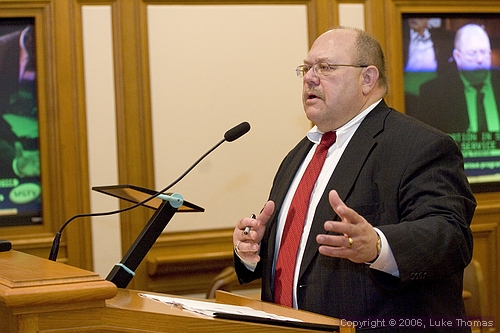
Bob Sifferman worked all through his weekend
to prepare an impassioned presentation on root causes of youth
malefaction.
Sifferman and colleagues energized members of the Select Committee
on Gun and Gang Violence with specifics confirming what they long
sensed, noted Chair Sophie Maxwell.
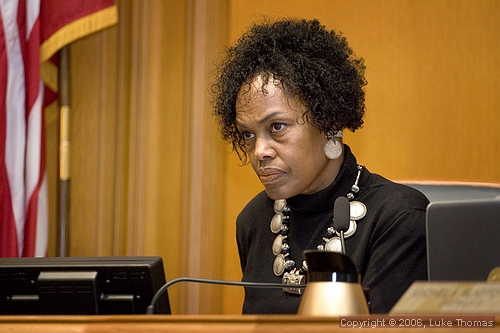
Gun and Gang Violence Committee Chair Sophie Maxwell
listens attentively to Sifferman's presentation.
Hopelessness is the cause, Sifferman said. Tracking indicates
that life circumstances begin to extinguish hope by the third
grade.
"They begin to fall back," observed Sifferman.
Those studies "suggest that most of the youth have either
witnessed or been victimized, or both, with violence," Sifferman
related.
"They've seen violence in their homes. They've experienced
violence in their homes. They've experienced violence in their
own lives. Some of them have carried out violence in other's lives."
DEFAULT DISPOSITION OF CONFLICT
"Violence is learned behavior - learned in the homes, in
TV, in movies, in exposure to videos," continued Sifferman.
"It has become a default disposition of conflict, and/or
a measure of gang participation.
"Violence spawns violence in greater measure."
WHAT WE'RE DOING ISN'T SUFFICIENT
"Add to that stories from counselors in (juvenile detention)
hall that now talk about the grandfathers of the kids they supervise
in the hall," Sifferman stated.
"They go back to the third generation.
"We need to be more strategic. We also know the basic institutions
of society - the family and the gang - which has the greater magnet?
Which has the greater juice? Which provides the greater sense
of security, nourishing, and support?
"We know it would be with affiliation with the gang.
"We need to shore up the families. We need to emphasize
jobs, the work we are providing in mental health treatment for
youth that need that, educational guidance and help.
"What we're doing isn't sufficient."
However insufficient, how are current resources being applied
to affect neighborhoods, Committee Member Ross Mirkarimi asked.
"They need to be more strategic and focused in identifying
those needs," responded Sifferman.
FRUITS OF INDIFFERENCE
Searing indictment of society indifference came in cold neighborhood
mapping of juvenile justice system youth.
It drew audible gasps from committee audience.
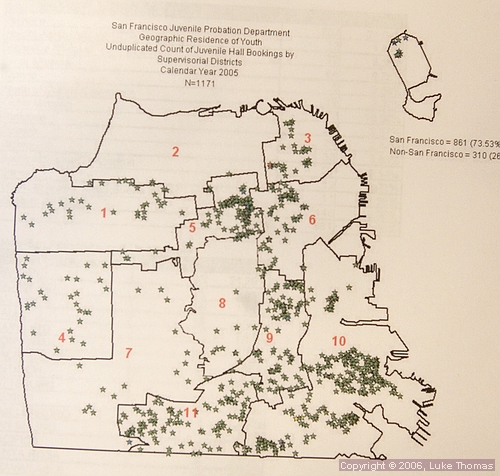
Crime mapping data shows correlation
between San Francisco's poorest neighborhoods and crime committed
by youth.
Ross Mirkarimi politely interupted Sifferman after
seeing the crime map to point out that the crime mapping data
for youth is almost identical to the mapping for adult crime and
hasn't changed in the last 30 years.
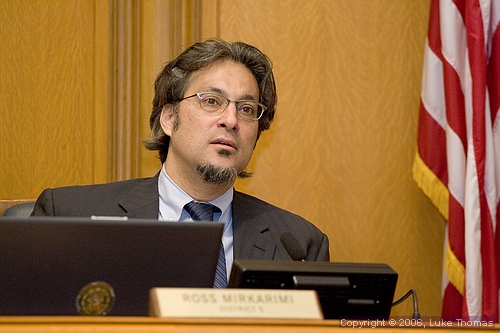
Supervisor Ross Mirkarimi
Sifferman proposed job opportunity set-asides for affected districts.
"We're looking for providing some signs of hope for kids
- kids that will be able to see a future with them in it and not
something where they make it to twenty-one it's a miracle."
He noted institutional resistance to change and funding restraints
impede solutions.
Necessary detention reform and adoption of restorative justice
programs successfully adopted in Chicago's Cook County is slowed
"by a marked institutional apathy toward change," Sifferman
noted.
Insufficient staffing compounds delay. Juvenile probation officers
carry a caseload of 30 youth while adult probation officers carry
five times that number.
SUCCESSFUL MODELS ALREADY EXIST
Successful intervention is community based and labor intensive,
Ray Balberan told the committee. Balberan has worked as a juvenile
justice advocate for 30 years, he said.
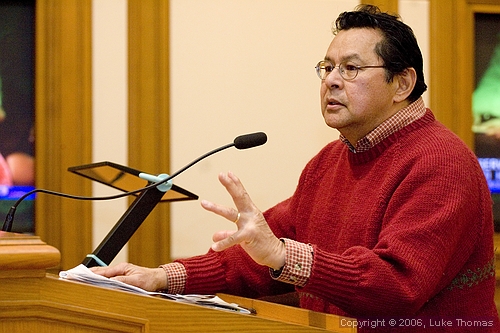
Ray Belberan, Mission Community Advocate for Social Justice
Balberan detailed case intervention.
"A young Mexican Filipino youth 16-year-old who was in the
high 6% of failed programs at Juvenile Hall - he failed out of
placement, he failed out of schools, they sent him far away, he
failed that," recalled Balberan
"They sent him far away. He failed that and then he came
back.
"He's still on probation and then he re-offended. He committed
a violence crime. A 16-year-old boy.
"It's a done deal. He's going to get five years in YA (California
Youth Authority) and we start working with him in detention.
"The work starts in detention. There's no such thing as
a silver bullet - a one-year program, a two-year program.
"The high risk youth, from our experiences, to supervise
them is a three to five year commitment.
"There's no such thing as 'we're going to deal with you
in one year, get you a job, goodbye.'
"We start working with him in developing a treatment plan.
"We bring in our own therapist to do a psych evaluation.
"We also start working with him about his dreams for education.
What kind of higher education does he really want?
"This is what we found out about him.
"His risk factors: he's a gang member in the Mission District,
he's violent, he uses drugs, he's a crack baby. He was born already
disposed with drug issues. And he and his members ran a prostitution
service.
"His strengths are: he wanted to be a carpenter, he loved
his family, he was good at math, and he was a leader.
"So we worked with him. We worked with him with a team of
case managers. This is what we do every day.
"The case manager and the psychiatrist came up with this
plan for him and offered it to the court.
"One - residential treatment at Asian American Residential
Program in San Francisco.
"Local 22 guaranteed that he would get a pension because
he got his GED.
"He would go to Upward Bound and through Upward Bound we
could get him to State (college).
"He would do individual therapy.
"He would go to San Francisco General Hospital because they
have a program for crack babies - there's medicine for crack babies.
"His family would go into therapy through United Family.
"He would have home based supervision from Probation and
he would be in a young men's group to build his esteem as a young
man and learn his culture.
"So we put that all together. We took it in front of Dianne
Feinstein and she gave him a chance to do that because he had
a lot of community support, a well thought out program.
"That's how we case manage every case.
"It's a high intense case management. We follow the kid
from the day he steps in.
"He may even complete probation, but so what? He's still
going to be at-risk because he lives in an at-risk environment.
"So we have to stay with him at least three to five years.
"I can give a kid a job right here. Say you're the kid -
here's the job, here's the paperwork, walk up to the mayor's office.
"I can lose you before you get to the mayor's office because
that's high risk behavior.
"So what I would say is, 'Here's the job. This young lady
is your case manager. She's going to walk you up there and she's
going to call you up at three in the morning, pick you up and
take you to the job.
"That's community work.
"Now we hear 'we need the community, the community this,
the community that.'
"We are the community and we're doing this on a shoestring
budget."
####
|